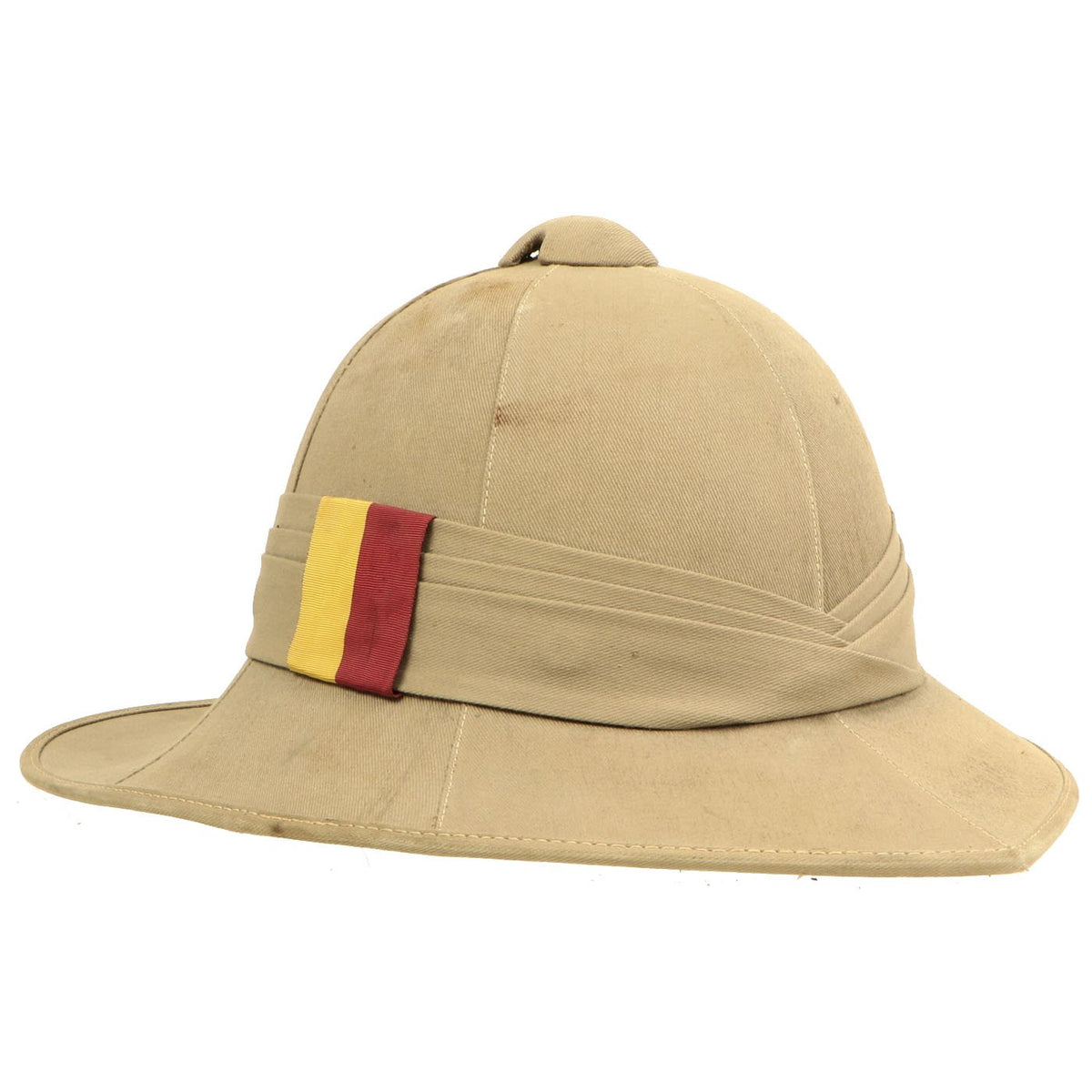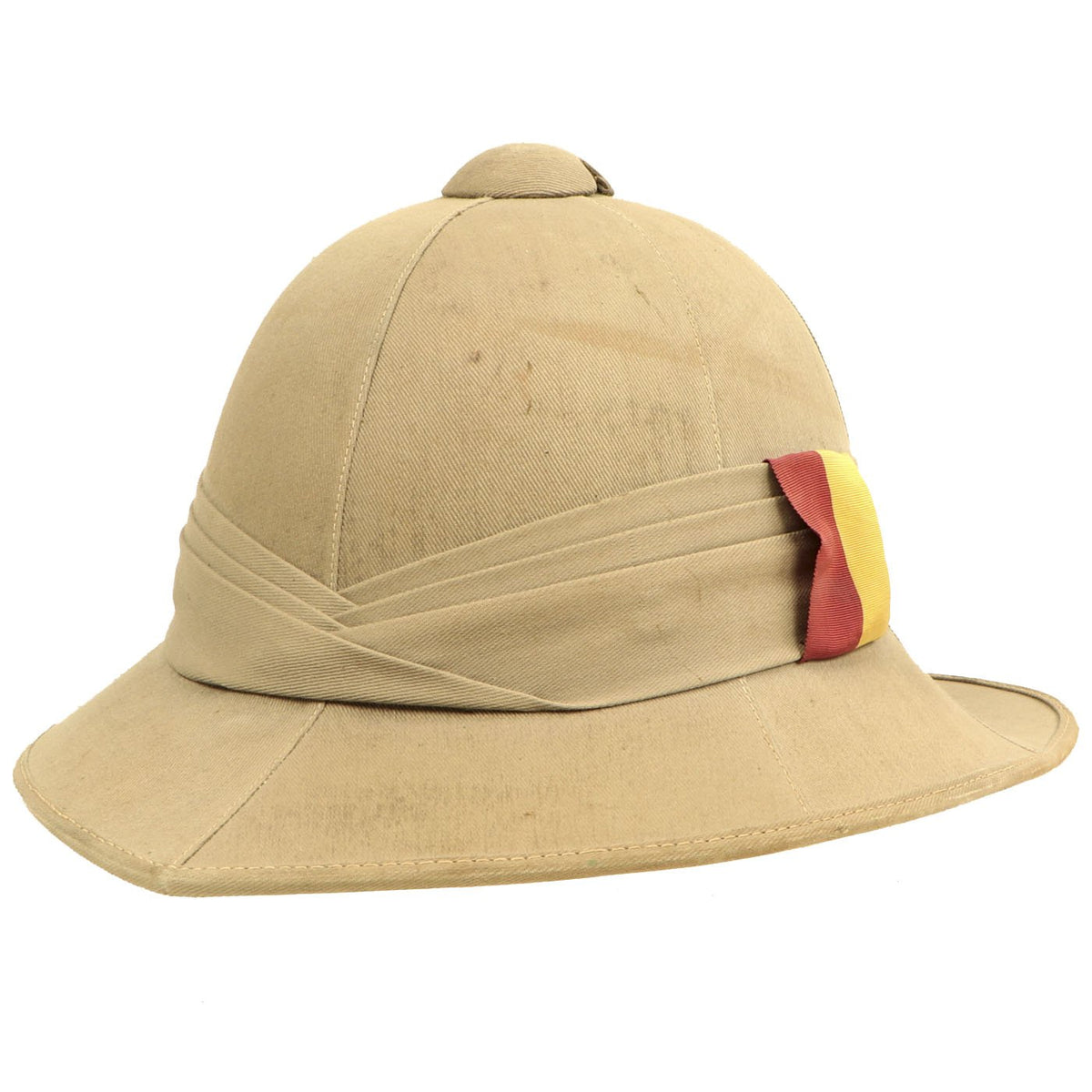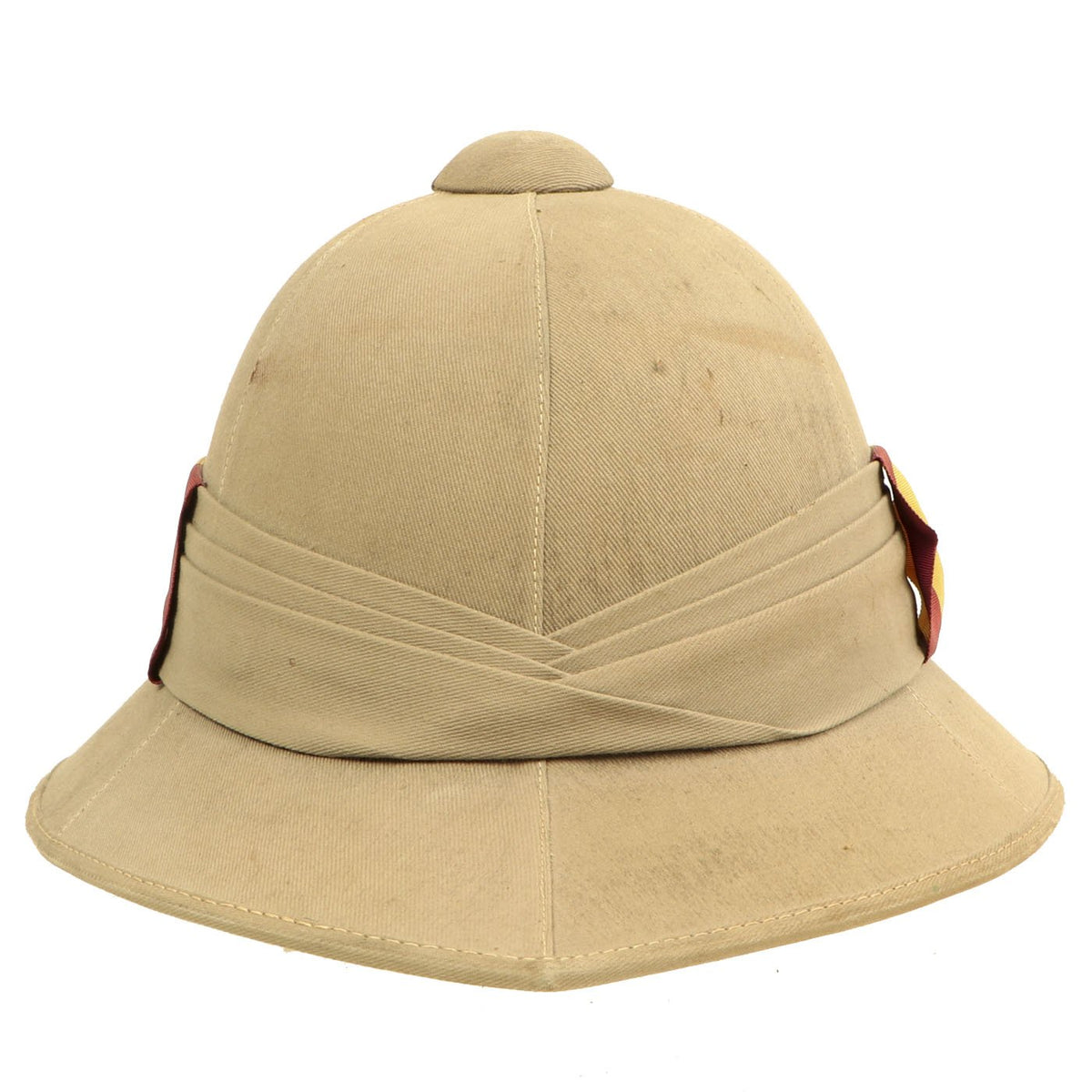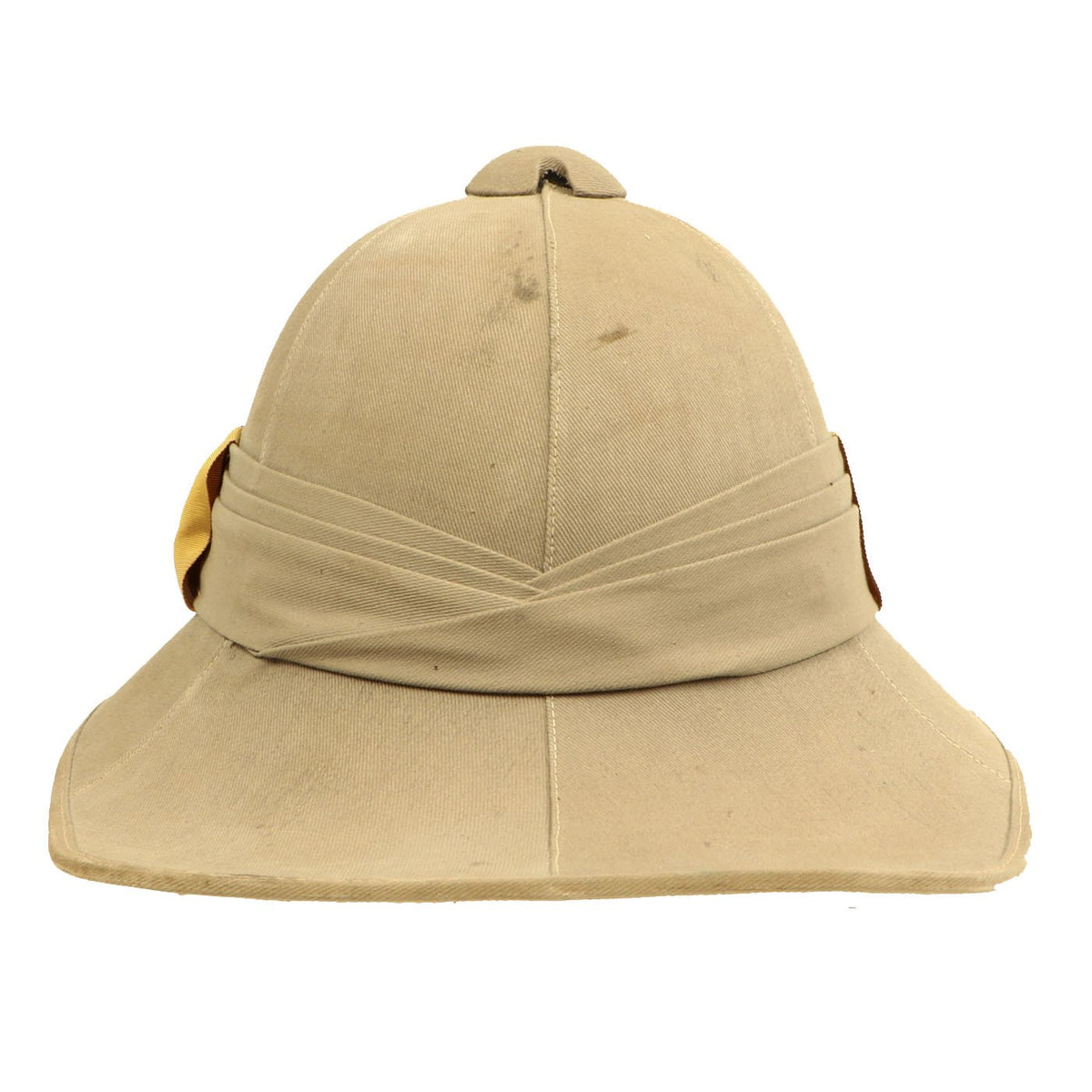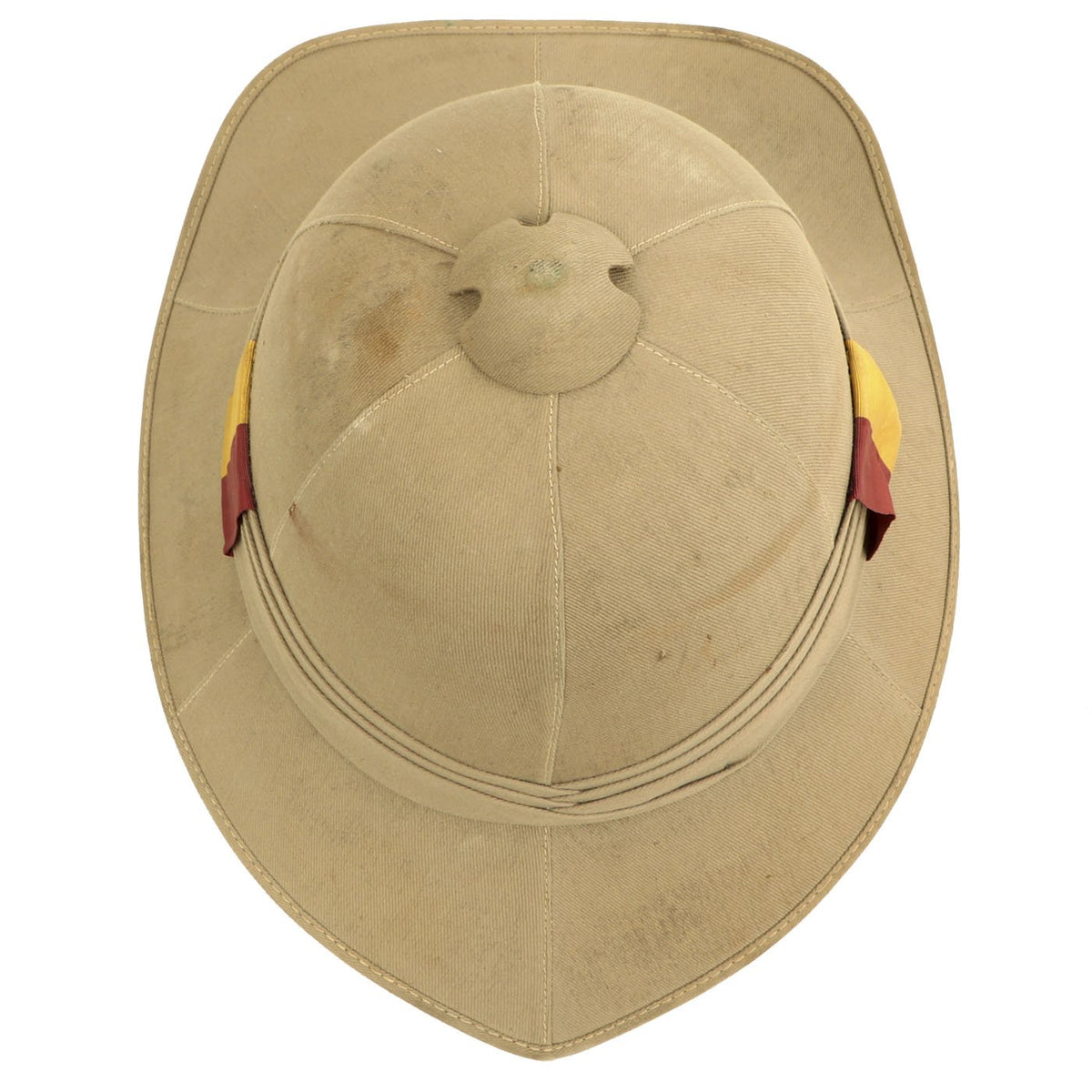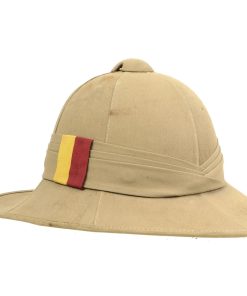Original British WWII 1942 Dated Wolseley Pattern Pith Sun Helmet with Suffolk Regiment Minden Flash by Moores of London Original Items
$ 295,00 $ 118,00
Original Item: Only One Available. Offered in splendid original condition this WW2 Wolseley Pattern pith sun helmet features a Suffolk Regiment Minden Flash on the both sides of the pugaree. A pugaree is the cloth wrap which surrounds the base of the exterior of the helmet.
The inside of the leather head band is marked-
The ‘Minden‘ Flash – the very symbol of the Suffolk Regiment was invented in the aftermath of the evacuation from Dunkirk. It was noted that trying to command quantities of men on a beach with no distinguishing form of regimental identification was pretty difficult. In early 1941, an Army Council instruction permitted the wearing of a Regimental Emblem provided that it had been sanctioned by the War Office. In late 1941, the first cloth shoulder titles were introduced. These were screen-printed white ‘Suffolk’ on a scarlet background and seem to have been issued first to the Second Line Battalion’s of the Regiment (the 8th, 30th and 70th), before the 1st Battalion. Printed insignia was designed to minimalist manufacturing costs and do away with costly, time consuming embroidered badges. The very earliest forms of the flash appear to have been made by the Battalion Tailor from woven woollen tapes (from we believe, garter flashes worn of foreign service) but soon demand required more and more to be made from a diminishing source of material. We therefore believe that these early printed Minden Flashes originate from early-mid 1941 when the first large scale use of printed insignia came into use.
Suffolk Regiment in World War Two
Regular Army
The 1st Battalion, Suffolk Regiment was a Regular Army unit stationed in Devonport as part of the 8th Infantry Brigade, 3rd Infantry Division and served with the British Expeditionary Force (BEF) in France from late 1939 to May 1940. The division was commanded by Major-General Bernard Montgomery. With the rest of the BEF, it was evacuated from Dunkirk in 1940. The next four years were spent training in the United Kingdom for the invasion of Normandy in 1944, otherwise known as D-Day. The 1st Battalion, under the command of Lieutenant Colonel Richard E. Goodwin, landed on Sword beach and was involved in attacking and taking the Hillman Fortress on D-Day itself. They served with the 3rd Infantry Division throughout the entire North West Europe Campaign from D-Day to Victory in Europe Day in 1945. By the end of the war the 1st Battalion had lost 215 men killed in action.
The 2nd Battalion of the Suffolk Regiment was serving in India at the outbreak of the Second World War, spending the early years of the war mainly deployed on internal security duties. In 1943 the battalion transferred to the 123rd Indian Infantry Brigade, part of the 5th Indian Infantry Division and served with them in the Burma Campaign. In 1944 the battalion was flown to Imphal to clear Japanese positions.
Territorial Army
The 4th/5th Battalion, Suffolk Regiment was a Territorial Army unit and was split to help re-create the 5th Battalion, which had been disbanded in the 1920s, in 1939 due to the Territorial Army being doubled as another conflict had, by this time, seemed inevitable. Both battalions were assigned to the 54th Infantry Brigade, which included the 4th Royal Norfolk Regiment, assigned to the 18th Infantry Division, a 2nd Line duplicate of the 54th (East Anglian) Infantry Division. Despite being a 2nd Line formation, the 18th Division contained many 1st Line units. The division spent the early years of the war in the defence of England and guarding against a possible German invasion after the bulk of the British Army was evacuated at Dunkirk. In late 1941 the 18th Division, the 4th and 5th Suffolks included, were originally to be sent to Egypt but instead were sent to Singapore to help strengthen the garrison there after Japan entered the war in December 1941. In early 1942, both the 4th and 5th battalions fought briefly in the defence of Singapore against the Japanese, with the 18th Division, before British Commonwealth forces on that island surrendered on 15 February 1942 under the orders of Lieutenant-General Arthur Percival. Men from the two battalions suffered great hardship as POWs and were forced to participate in the construction of the Burma Railway.
Hostilities-only
The 7th Battalion, Suffolk Regiment was a war-formed unit raised in June 1940, shortly after Dunkirk, and, on 10 October, was assigned to the 210th Independent Infantry Brigade (Home) alongside other hostilities-only battalions. With the brigade, the battalion alternated between home defence duties and training to repel an expected invasion of the United Kingdom. In November 1941, with the threat of invasion reduced due to the oncoming winter, the battalion was converted to a regiment in the Royal Armoured Corps, becoming 142nd Regiment Royal Armoured Corps (142 RAC) and joined 25th Army Tank Brigade. They continued to wear their Suffolk Regiment cap badge on the black beret of the Royal Armoured Corps as did all infantry units converted this way.[32] Equipped with Churchill tanks the regiment landed at Algiers in 1943, fighting at the Battle of Medjez-el Bab in the Tunisia Campaign in April 1943. After the end of the fighting in North Africa the regiment remained there until April 1944 when, with the rest of the brigade, it landed at Naples, Italy, destined for service in the Italian campaign, where they fought in Operation Diadem, where the Allies finally broke out of the Gustav Line. 142 RAC was present when the Allies overcame the Line and the Gothic Line in late 1944. However, due to a shortage of manpower, the regiment was disbanded in January 1945 while in northern Italy.
The 50th (Holding) Battalion was created in late May 1940, around the time of the Dunkirk evacuation, and was originally intended temporarily to ‘hold’ men who were medically unfit, awaiting orders, or, as this was at the time of Dunkirk, returning from overseas service. However, in October, the battalion was re-designated as the 8th Battalion. In addition, the 6th, 9th, 30th, 31st and 70th (Young Soldiers) Battalions were also formed, although none of these saw service overseas.
The Wolseley pattern helmet is a distinctive British design developed and popularized in the late 19th and early 20th century. It was the official designation for the universal sun helmet worn by the British Army from 1899 to 1948 and described in the 1900 Dress Regulations as “the Wolseley pattern cork helmet”. With its swept-back brim it provided greater protection from the sun than the old Colonial pattern helmet, and its use was soon widespread among British personnel serving overseas as well as some Canadian units.
Fast Shipping with Professional Packaging
Thanks to our longstanding association with UPS FedEx DHL, and other major international carriers, we are able to provide a range of shipping options. Our warehouse staff is expertly trained and will wrap your products according to our exact and precise specifications. Prior to shipping, your goods will be thoroughly examined and securely secured. We ship to thousands clients each day across multiple countries. This shows how we're dedicated to be the largest retailer on the internet. Warehouses and distribution centres can be located throughout Europe as well as the USA.
Note: Orders with more than one item will be assigned a processing date depending on the item.
Before shipping before shipping, we'll conduct a thorough inspection of the items you have ordered. Today, the majority of orders will be delivered within 48 hours. The delivery time will be between 3-7 days.
Returns
The stock is dynamic and we cannot completely manage it because multiple stakeholders are involved, including our factory and warehouse. So the actual stock may alter at any time. It's possible that you may not receive your order once the order has been made.
Our policy is valid for a period of 30 days. If you don't receive the product within 30 days, we are not able to issue a refund or an exchange.
You can only return an item if it is unused and in the same state as the day you received it. You must have the item in its original packaging.
Related products
Uncategorized
Uncategorized
Uncategorized
Uncategorized
Uncategorized
Uncategorized
Uncategorized
Uncategorized
Uncategorized
Armoured Fighting Vehicles of the World: AFVs of World War One (Hardcover Book) New Made Items
Uncategorized
Uncategorized
Uncategorized
Armored Burgonet Helmet & Polearm from Scottish Castle Leith Hall Circa 1700 Original Items
Uncategorized
Uncategorized
Uncategorized
Uncategorized
Uncategorized
Band of Brothers ORIGINAL GERMAN WWII Le. F.H. 18 10.5cm ARTILLERY PIECE Original Items
Uncategorized
Angolan Rebel 1970s era 60mm Inert Display Mortar from Angolan Civil War Original Items
